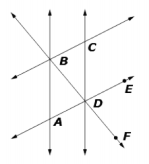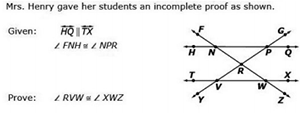Clusters should not be sorted from Major to Supporting and then taught in that order. To do so would strip the coherence of the mathematical ideas and miss the opportunity to enhance the major work of the grade with the supporting clusters.
- Assessment Limits :
Items may assess relationships between vertical angles, special angles
formed by parallel lines and transversals, angle bisectors, congruent
supplements, congruent complements, and a perpendicular bisector
of a line segment.Items may have multiple sets of lines and angles.
Items may include narrative proofs, flow-chart proofs, two-column
proofs, or informal proofs.In items that require the student to justify, the student should not be
required to recall from memory the formal name of a theorem. - Calculator :
Neutral
- Clarification :
Students will prove theorems about lines.Students will prove theorems about angles.
Students will use theorems about lines to solve problems.
Students will use theorems about angles to solve problems.
- Stimulus Attributes :
Items may be set in a real-world or mathematical context. - Response Attributes :
Items may require the student to give statements and/or
justifications to complete formal and informal proofs.Items may require the student to justify a conclusion from a
construction.
- Test Item #: Sample Item 1
- Question:
In the figure,
 . Let
. Let  measure (3x+4)º,
measure (3x+4)º,  measure(6x-8)º, and
measure(6x-8)º, and  measure (7x-20)º.
measure (7x-20)º.
Click on the blank to enter the degree measure that completes the equation shown.
- Difficulty: N/A
- Type: EE: Equation Editor
- Test Item #: Sample Item 2
- Question:

Complete the proof by dragging the correct reasons to the table for line 3 and 6.
- Difficulty: N/A
- Type: DDHT: Drag-and-Drop Hot Text
Related Courses
Related Access Points
Related Resources
Formative Assessments
Image/Photograph
Lesson Plans
Problem-Solving Tasks
Tutorials
MFAS Formative Assessments
Students are asked to prove that a point on the perpendicular bisector of a line segment is equidistant from the endpoints of the segment.
Students are asked to find the measures of angles formed by three concurrent lines and to justify their answers.
Students are asked to find the measures of angles formed by two parallel lines and a transversal.
Students are asked to find the measures of angles formed by two parallel lines and two transversals.
Students are asked to describe a triangle whose vertices are the endpoints of a segment and a point on the perpendicular bisector of a segment.
In a diagram involving two parallel lines and a transversal, students are asked to use rigid motion to prove that alternate interior angles are congruent.
Students are asked to identify a pair of vertical angles in a diagram and then prove that they are congruent.
Student Resources
Problem-Solving Tasks
This task asks students to show how certain points on a plane are equidistant to points on a segment when placed on a perpendicular bisector.
Type: Problem-Solving Task
This problem solving task challenges students to find the perpendicular meeting point of a segment from the center of a circle and a tangent.
Type: Problem-Solving Task
Tutorials
In this tutorial, students will find the measures of angles formed when a transversal cuts two parallel lines.
Type: Tutorial
This tutorial shows students the eight angles formed when two parallel lines are cut by a transversal line. There is also a review of triangles in this video.
Type: Tutorial
Students will see in this tutorial the eight angles formed when two parallel lines are cut by a transversal line.
Type: Tutorial
In this tutorial, students will learn the angle measures when two parallel lines are cut by a transversal line.
Type: Tutorial
In this video, students will learn how to use what they know about the sum of angles in a triangle to determine the sum of the exterior angles of an irregular pentagon.
Type: Tutorial
In this tutorial, students prove that vertical angles are equal. Students should have an understanding of supplementary angles before viewing this video.
Type: Tutorial
Students will use algebra to find the measure of vertical angles, or angles opposite each other when two lines cross. Students should have an understanding of complementary and supplementary angles before viewing this video.
Type: Tutorial
In this tutorial, students will use their knowledge of supplementary, adjacent, and vertical angles to solve problems involving the intersection of two lines.
Type: Tutorial
We will use algebra in order to find the measure of angles formed by a transversal.
Type: Tutorial
We will be able to identify corresponding angles of parallel lines.
Type: Tutorial
We will gain an understanding of how angles formed by transversals compare to each other.
Type: Tutorial
This 5 minute video gives the proof that vertical angles are equal.
Type: Tutorial
Parent Resources
Problem-Solving Tasks
This task asks students to show how certain points on a plane are equidistant to points on a segment when placed on a perpendicular bisector.
Type: Problem-Solving Task
This problem solving task challenges students to find the perpendicular meeting point of a segment from the center of a circle and a tangent.
Type: Problem-Solving Task









